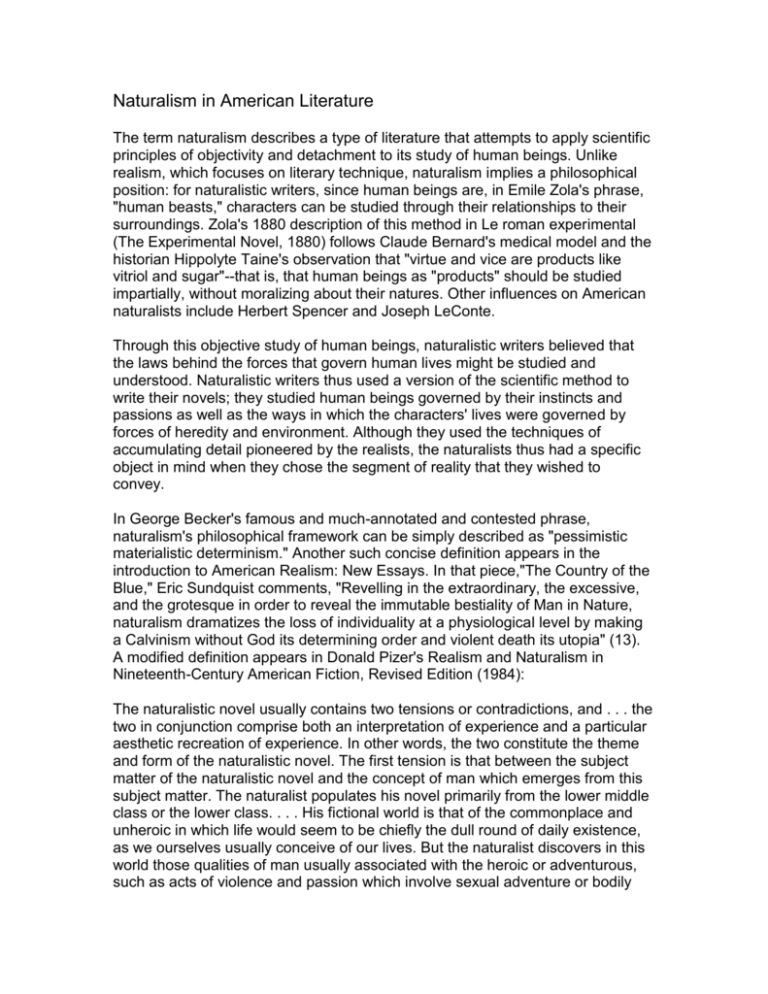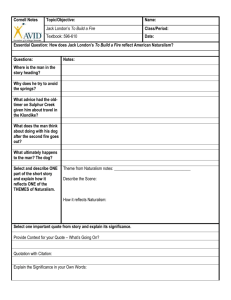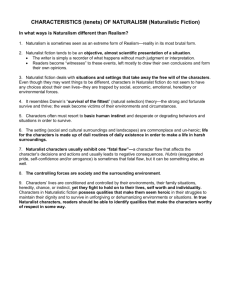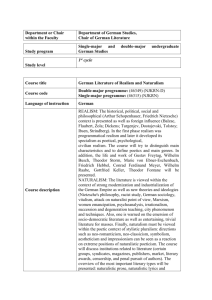Naturalism in American Literature: Definition & Characteristics
advertisement

Naturalism in American Literature The term naturalism describes a type of literature that attempts to apply scientific principles of objectivity and detachment to its study of human beings. Unlike realism, which focuses on literary technique, naturalism implies a philosophical position: for naturalistic writers, since human beings are, in Emile Zola's phrase, "human beasts," characters can be studied through their relationships to their surroundings. Zola's 1880 description of this method in Le roman experimental (The Experimental Novel, 1880) follows Claude Bernard's medical model and the historian Hippolyte Taine's observation that "virtue and vice are products like vitriol and sugar"--that is, that human beings as "products" should be studied impartially, without moralizing about their natures. Other influences on American naturalists include Herbert Spencer and Joseph LeConte. Through this objective study of human beings, naturalistic writers believed that the laws behind the forces that govern human lives might be studied and understood. Naturalistic writers thus used a version of the scientific method to write their novels; they studied human beings governed by their instincts and passions as well as the ways in which the characters' lives were governed by forces of heredity and environment. Although they used the techniques of accumulating detail pioneered by the realists, the naturalists thus had a specific object in mind when they chose the segment of reality that they wished to convey. In George Becker's famous and much-annotated and contested phrase, naturalism's philosophical framework can be simply described as "pessimistic materialistic determinism." Another such concise definition appears in the introduction to American Realism: New Essays. In that piece,"The Country of the Blue," Eric Sundquist comments, "Revelling in the extraordinary, the excessive, and the grotesque in order to reveal the immutable bestiality of Man in Nature, naturalism dramatizes the loss of individuality at a physiological level by making a Calvinism without God its determining order and violent death its utopia" (13). A modified definition appears in Donald Pizer's Realism and Naturalism in Nineteenth-Century American Fiction, Revised Edition (1984): The naturalistic novel usually contains two tensions or contradictions, and . . . the two in conjunction comprise both an interpretation of experience and a particular aesthetic recreation of experience. In other words, the two constitute the theme and form of the naturalistic novel. The first tension is that between the subject matter of the naturalistic novel and the concept of man which emerges from this subject matter. The naturalist populates his novel primarily from the lower middle class or the lower class. . . . His fictional world is that of the commonplace and unheroic in which life would seem to be chiefly the dull round of daily existence, as we ourselves usually conceive of our lives. But the naturalist discovers in this world those qualities of man usually associated with the heroic or adventurous, such as acts of violence and passion which involve sexual adventure or bodily strength and which culminate in desperate moments and violent death. A naturalistic novel is thus an extension of realism only in the sense that both modes often deal with the local and contemporary. The naturalist, however, discovers in this material the extraordinary and excessive in human nature. The second tension involves the theme of the naturalistic novel. The naturalist often describes his characters as though they are conditioned and controlled by environment, heredity, instinct, or chance. But he also suggests a compensating humanistic value in his characters or their fates which affirms the significance of the individual and of his life. The tension here is that between the naturalist's desire to represent in fiction the new, discomfiting truths which he has found in the ideas and life of his late nineteenth-century world, and also his desire to find some meaning in experience which reasserts the validity of the human enterprise. (10-11) For further definitions, see also The Cambridge Guide to American Realism and Naturalism, Charles Child Walcutt's American Literary Naturalism: A Divided Stream, June Howard's Form and History in American Literary Naturalism, Walter Benn Michaels's The Gold Standard and the Logic of Naturalism, Lee Clark Mitchell's Determined Fictions, Mark Selzer's Bodies and Machines, and other works from the naturalism bibliography. See Lars Ahnebrink, Richard Lehan, and Louis J. Budd for information on the intellectual European and American backgrounds of naturalism. Characteristics Characters. Frequently but not invariably ill-educated or lower-class characters whose lives are governed by the forces of heredity, instinct, and passion. Their attempts at exercising free will or choice are hamstrung by forces beyond their control; social Darwinism and other theories help to explain their fates to the reader. See June Howard's Form and History for information on the spectator in naturalism. Setting. Frequently an urban setting, as in Norris's McTeague. See Lee Clark Mitchell's Determined Fictions, Philip Fisher's Hard Facts, and James R. Giles's The Naturalistic Inner-City Novel in America. Techniques and plots. 1. Walcutt says that the naturalistic novel offers "clinical, panoramic, slice-of-life" drama that is often a "chronicle of despair" (21). The novel of degeneration-Zola's L'Assommoir and Norris's Vandover and the Brute, for example--is also a common type. Walcutt identifies survival, determinism, violence, and taboo as key themes. 2. The "brute within" each individual, comprised of strong and often warring emotions: passions, such as lust, greed, or the desire for dominance or pleasure; and the fight for survival in an amoral, indifferent universe. The conflict in naturalistic novels is often "man against nature" or "man against himself" as characters struggle to retain a "veneer of civilization" despite external pressures that threaten to release the "brute within." 3. Nature as an indifferent force acting on the lives of human beings. The romantic vision of Wordsworth--that "nature never did betray the heart that loved her"--here becomes Stephen Crane's view in "The Open Boat": "This tower was a giant, standing with its back to the plight of the ants. It represented in a degree, to the correspondent, the serenity of nature amid the struggles of the individual-nature in the wind, and nature in the vision of men. She did not seem cruel to him then, nor beneficent, nor treacherous, nor wise. But she was indifferent, flatly indifferent." 4. The forces of heredity and environment as they affect--and afflict--individual lives. 5. An indifferent, deterministic universe. Naturalistic texts often describe the futile attempts of human beings to exercise free will, often ironically presented, in this universe that reveals free will as an illusion. Practitioners Frank Norris Theodore Dreiser Jack London Stephen Crane Edith Wharton, The House of Mirth (1905) Ellen Glasgow, Barren Ground (1925) John Dos Passos (1896-1970), U.S.A. trilogy(1938): The 42nd Parallel (1930), 1919 (1932), and The Big Money (1936) James T. Farrell (1904-1979), Studs Lonigan (1934) John Steinbeck (1902-1968), The Grapes of Wrath (1939) Richard Wright, Native Son (1940), Black Boy (1945) Norman Mailer (1923- ), The Naked and the Dead (1948) William Styron, Lie Down in Darkness (1951) Saul Bellow, The Adventures of Augie March (1953) To cite this page on a Works Cited page according to current MLA guidelines, supply the correct dates and use this format: Campbell, Donna M. "Naturalism in American Literature." Literary Movements. Date of publication or most recent update (listed above as the "last modified" date; you don't need to put the time down as well). Date you accessed the page. <http://www.wsu.edu/~campbelld/amlit/natural.htm>.









